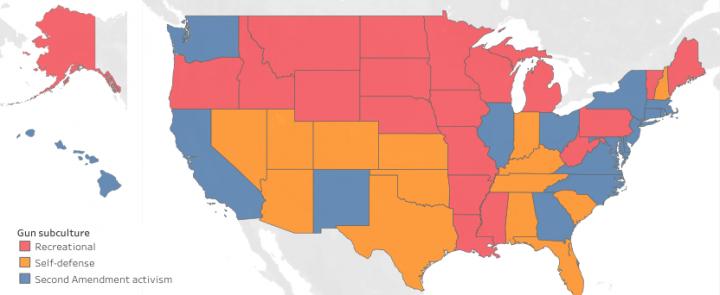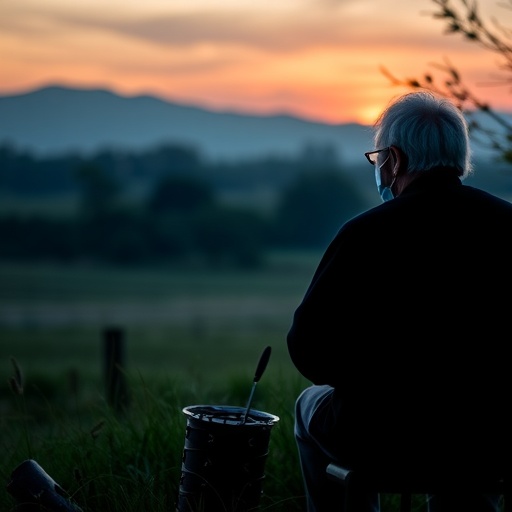Leading firearm violence prevention researchers are first to use data to show differences in gun culture across the country, identifying gun cultures around recreation, self-defense, and politics.

Credit: Boine et al.
Leading firearm violence prevention researchers are first to use data to show differences in gun culture across the country, identifying gun cultures around recreation, self-defense, and politics.
A new Boston University School of Public Health (BUSPH) study published in the Nature journal Humanities & Social Sciences Communications, shows that gun ownership means very different things in different parts of the United States.
Previous researchers have proposed two strands of gun culture: one focused on recreational use and a second on self-defense. But this study identifies a third, of people who do not view the defense of the Second Amendment as a means to an end, but as necessary to any freedom in this country. The study finds that this “Gun Culture 3.0” has increased the most in states that have strengthened their gun laws to the greatest degree, suggesting it may be grounded in fear of perceived threats by the government.
“The NRA has been spreading insurrectionist rhetoric for the past few decades, undermining Americans’ trust in their legislators and the federal government, while passing for a patriotic organization. The result is a few million people who are convinced that any genuine firearm violence prevention effort is the first step in a scheme to take away all of their rights and disenfranchise them,” says study lead author Claire Boine, a research scholar in community health sciences at BUSPH.
Using data on gun-related behaviors including hunting, NRA membership, magazine subscriptions, handgun and long gun purchases, and certain gun laws, the researchers show that American gun owners vary widely in the symbolic meaning they find in firearms and how they use them.
Over the last 20 years, at the national level, firearm recreation has dwindled and self-defense has expanded, even as a distinct culture of Second Amendment political advocacy has sprung up, the researchers found.
They also identified wide variation between states. Certain states, such as New York and Massachusetts, have very low recreational and self-defense gun cultures but very high Second Amendment activism. In contrast, states such as South Dakota have high recreational and self-defense cultures and little Second Amendment activism. Other states, such as Florida, have a high degree of self-defense gun culture and less recreational and Second Amendment gun culture.
The researchers found more emphasis on recreation in politically conservative states with large rural areas, little racial diversity, and few firearm regulations, while emphasis on self-defense is more common in politically conservative states that have enacted few new firearm laws in the last 20 years, have large rural areas, and are experiencing higher unemployment levels. The Second Amendment-focused “Gun Culture 3.0” is most common in liberal states, states where more of the population lives in an urban setting or is Hispanic, and states with stronger firearm regulations.
The researchers explain that the study shows only a marginal part of American gun culture is political, and the ability to measure gun culture empirically, as demonstrated by this study, will help better account for this variation in future studies of how gun policy affects gun use and violence.
“No longer can we speak about gun culture as if it is a single entity. There are positive aspects to gun culture that bring recreation, enjoyment, or a feeling of security to many people, and there are also some negative elements,” says Dr. Michael Siegel, professor of community health sciences at BUSPH.
“Those of us in public health must acknowledge the positive aspects of that culture and stop blaming law-abiding gun owners for the problem of firearm violence,” he says. “Instead, we need to address one very specific aspect of gun culture that the NRA has created that does not represent the overwhelming number of gun owners in this country.”
###
Read the full study here: https:/
About the Boston University School of Public Health
Founded in 1976, the Boston University School of Public Health is one of the top five ranked private schools of public health in the world. It offers master’s- and doctoral-level education in public health. The faculty in six departments conduct policy-changing public health research around the world, with the mission of improving the health of populations–especially the disadvantaged, underserved, and vulnerable–locally and globally.
Media Contact
Michelle Samuels
[email protected]




